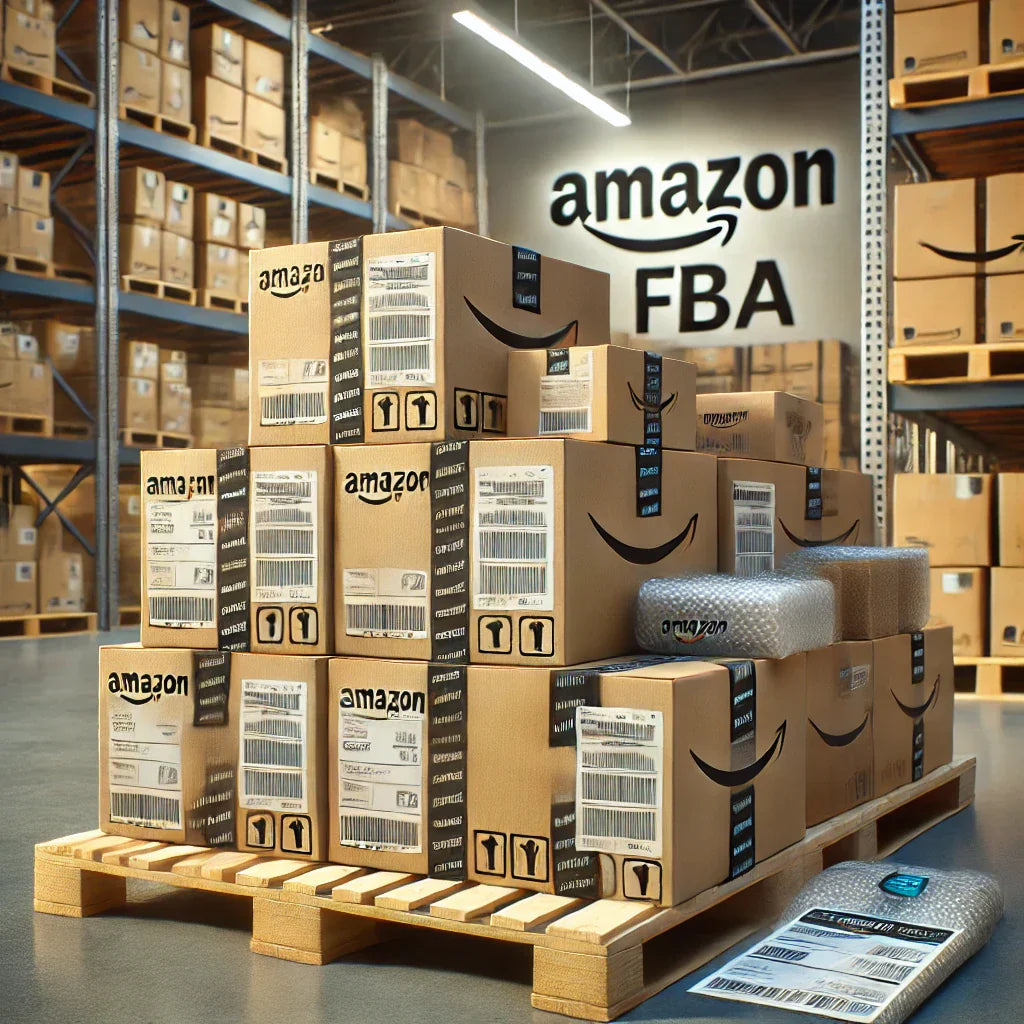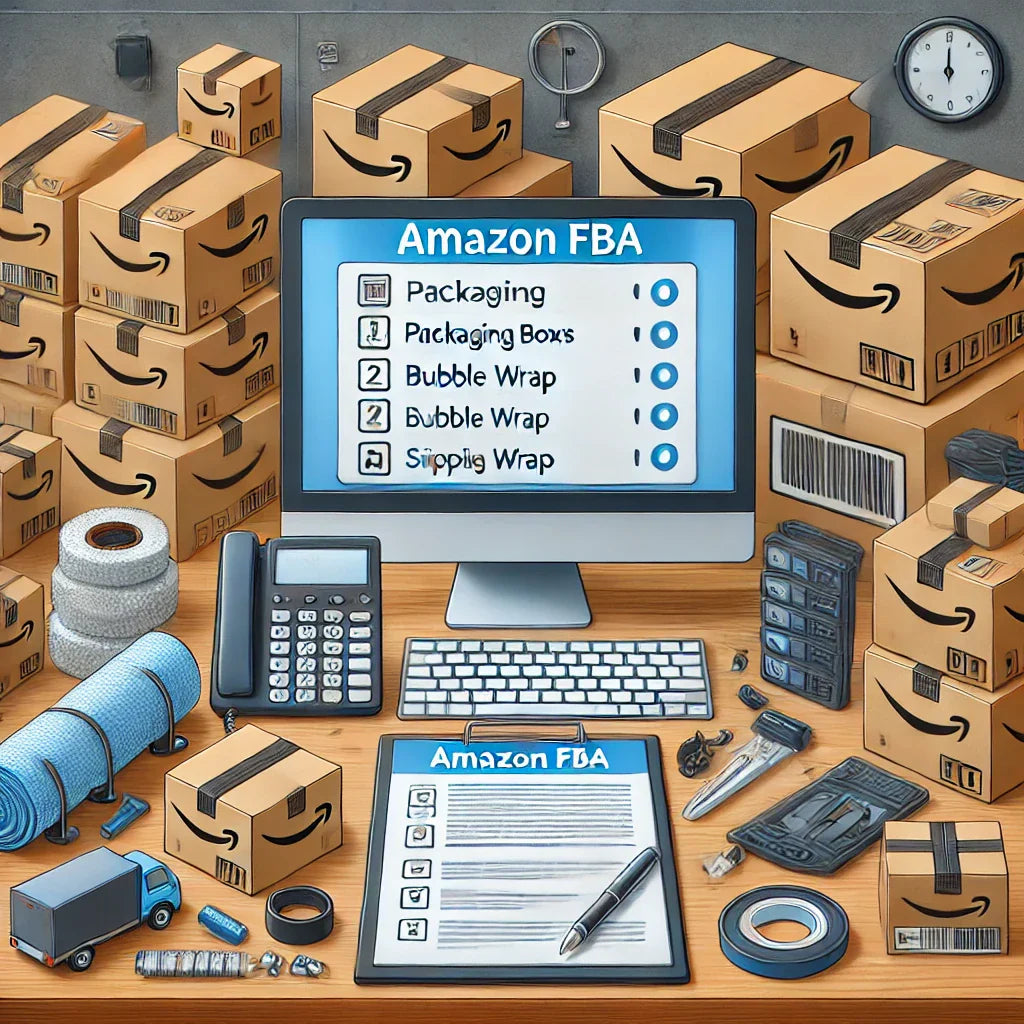Navigating the world of Amazon FBA (Fulfillment by Amazon) can be a game-changer for online sellers, offering them a streamlined pathway to reach millions of potential customers. However, as beneficial as it is, the process comes with its own set of challenges—especially during the critical FBA prep stage. Avoiding common Amazon FBA prep mistakes can make the difference between a successful, smooth-running business and one plagued by unexpected delays, extra costs, and frustrated customers. In this guide, we’ll explore expert advice for Amazon FBA sellers, focusing on frequent prep pitfalls and how to sidestep them, ensuring your products reach customers seamlessly and your seller metrics stay high. From labeling and packaging to compliance and inventory management, our tips will help you approach FBA prep with confidence, setting your business up for long-term success on Amazon’s marketplace.

Understanding Amazon FBA Prep: Why It Matters
FBA Prep Overview and Importance
Amazon FBA prep involves preparing your products to meet Amazon’s strict warehousing, packaging, and labeling requirements before they are shipped to Amazon’s fulfillment centers. Proper preparation minimizes potential issues such as labeling errors, damaged goods, or inventory inaccuracies that could impact your seller rating or result in costly fees.
Common Mistakes in FBA Prep
Understanding what can go wrong is the first step in avoiding these pitfalls. Many sellers new to FBA underestimate Amazon’s requirements or assume their current processes will suffice. Common mistakes in Amazon FBA prep include incorrect labeling, non-compliant packaging, and poor inventory management—all of which can result in unnecessary delays, unexpected fees, or even suspension of seller privileges.
Mistake #1: Failing to Comply with Amazon's Labeling Requirements
Labeling Guidelines
Amazon has strict labeling requirements that must be followed to ensure that inventory is tracked correctly and arrives at the right destination. Sellers must include readable, scannable barcodes on all products and may also need to add Amazon’s FNSKU (Fulfillment Network Stock Keeping Unit) label.
Common Labeling Errors
- Improper Label Placement: Labels should be clearly visible and not placed on a curved surface or near a product’s barcode, which can cause scanning issues.
- Incorrect Label Format: Labels must match Amazon’s format requirements and should be easy to scan.
- Mixed Labels: Using both manufacturer barcodes and Amazon barcodes can confuse the system, causing inventory management issues.
How to Avoid Labeling Mistakes
- Double-Check Label Placement: Place FNSKU labels in a visible, flat area to avoid scanner issues.
- Use High-Quality Labels: Invest in durable, high-quality labels that can withstand transit conditions.
- Separate Manufacturer Barcodes: Make sure only the FNSKU label is visible on products, covering other barcodes if necessary.
Mistake #2: Incorrect Product Packaging
Amazon's Packaging Guidelines
Amazon enforces packaging guidelines to ensure that products arrive safely and efficiently. Products must be packed securely, with appropriate protection for fragile items, and meet specific requirements based on product type (e.g., poly bags, bubble wrap, or boxes).
Common Packaging Errors
- Insufficient Protection for Fragile Items: Fragile items need additional protection to survive Amazon’s handling processes.
- Non-Compliant Packaging Materials: Certain items, like liquids or powders, must be packaged in leak-proof containers.
- Incorrect Poly Bag Usage: If using poly bags, they must be at least 1.5 mil thick and have a suffocation warning.
How to Avoid Packaging Mistakes
- Review Amazon’s Packaging Rules: Understand the specific requirements for each product category.
- Invest in Quality Packaging Materials: Use durable, high-quality packaging to protect items from potential damage.
- Add Protective Materials: Use bubble wrap or air pillows for fragile products, and ensure poly bags meet Amazon’s standards.
Mistake #3: Ignoring Product Size and Weight Restrictions
Amazon's Size and Weight Categories
Products shipped through FBA are classified into categories based on size and weight. Misclassifying items can lead to unexpected fees or delays in receiving items at Amazon’s fulfillment centers.
Common Size and Weight Errors
- Incorrect Product Measurements: Measuring the product incorrectly can result in inaccurate category placement.
- Failure to Consider Packaging Weight: Packaging weight can change an item’s classification, affecting fees.
- Ignoring Oversized Item Guidelines: Oversized items have additional costs and require special preparation.
How to Avoid Size and Weight Mistakes
- Measure Accurately: Use precise measurements for the product and packaging.
- Account for Packaging Weight: Always calculate the final packaged weight before classifying items.
- Be Aware of Oversize Restrictions: Understand the cost implications and restrictions for oversized items.
Mistake #4: Mismanaging Inventory Levels
Inventory Management Best Practices
Amazon expects sellers to maintain healthy inventory levels to avoid out-of-stock situations. Mismanagement can lead to lower product ranking, customer dissatisfaction, or long-term storage fees.
Common Inventory Management Mistakes
- Underestimating Demand: Failing to predict demand can lead to stockouts, hurting your rankings and disappointing customers.
- Overstocking: Overstocking can result in high storage fees and potential losses if the product doesn’t sell as expected.
- Poor Tracking of Reorders: Not planning reorder schedules can disrupt inventory flow.
How to Avoid Inventory Management Mistakes
- Utilize Inventory Management Software: Use tools that integrate with Amazon to monitor stock levels and track sales trends.
- Set Reorder Points: Establish reorder points to ensure you never run out of stock during peak periods.
- Monitor Seasonality: Adjust inventory levels based on seasonal trends to avoid overstocking or understocking.
Mistake #5: Not Understanding Amazon’s Restricted Products Policy
Amazon’s Restricted Products Policy
Amazon has a list of restricted and prohibited products that sellers cannot list through FBA. Violating these policies can lead to account suspension, so it’s crucial to stay updated on Amazon’s restrictions.
Common Restricted Products Errors
- Listing Prohibited Products: Listing restricted items, even unknowingly, can result in serious consequences.
- Failure to Check Product Updates: Amazon frequently updates its restricted products list, so a previously allowed item may now be restricted.
- Improperly Storing Hazardous Materials: FBA has strict rules on hazardous materials (hazmat) that require special handling and storage.
How to Avoid Restricted Products Mistakes
- Review Restricted Products Guidelines Regularly: Check Amazon’s policy updates to ensure you are compliant.
- Use Amazon’s Compliance Tools: Amazon offers tools to help sellers determine if a product is restricted.
- Understand Hazmat Regulations: If selling hazardous items, follow Amazon’s hazmat policy closely to avoid penalties.
Mistake #6: Poor Product Condition and Quality Control
Importance of Quality Control in FBA
Product condition is a critical factor for maintaining customer satisfaction and positive reviews. Poor quality control can result in product returns, complaints, and ultimately a lower seller rating.
Common Quality Control Errors
- Skipping Product Inspections: Failing to inspect products before shipping them to Amazon can lead to sending defective items.
- Overlooking Packaging Quality: Poor packaging can damage items, leading to negative reviews.
- Inadequate Testing of New Suppliers: New suppliers may not meet your quality standards, impacting customer satisfaction.
How to Avoid Quality Control Mistakes
- Conduct Pre-Shipment Inspections: Inspect all products before sending them to Amazon to ensure quality.
- Work with Reliable Suppliers: Build relationships with trusted suppliers and test their products periodically.
- Ensure Consistent Packaging Standards: Use standardized packaging that meets Amazon’s quality requirements.

Mistake #7: Underestimating Amazon FBA Fees
Understanding FBA Fee Structure
Amazon FBA fees include storage fees, fulfillment fees, and optional service fees. Misunderstanding these fees can impact profitability and prevent proper budget planning.
Common FBA Fee Errors
- Failing to Factor in Long-Term Storage Fees: Items held in Amazon’s warehouse for over a year incur additional fees.
- Misclassifying Product Size and Weight: Incorrect product classification can lead to higher fees.
- Ignoring Other Fees: Additional costs, such as removal fees for unsellable items, can add up quickly.
How to Avoid Fee-Related Mistakes
- Understand Amazon’s Fee Structure: Familiarize yourself with storage, fulfillment, and other associated costs.
- Monitor Inventory Age: Use inventory management tools to track the age of your products to avoid long-term storage fees.
- Regularly Review FBA Reports: Amazon provides detailed reports that help sellers understand their fees and make adjustments.
Mistake #8: Not Preparing for Returns and Refunds
Returns and Refund Policy for Amazon Sellers
Returns are inevitable in e-commerce, but improper handling can negatively impact customer satisfaction and your seller rating. Amazon’s FBA return policy allows customers to return products with minimal hassle, but sellers are responsible for managing these returns correctly.
Common Returns Mistakes
- Ignoring Product Quality in Returns: Failing to assess returned items can lead to reselling defective products.
- Poor Customer Communication: Lack of clear communication can result in dissatisfied customers.
Mistake #9: Not Utilizing Amazon’s FBA Prep Services When Necessary
Overview of Amazon FBA Prep Services
Amazon offers FBA Prep Services for sellers who may struggle with fulfilling certain prep requirements. These services cover a range of tasks, including labeling, packaging, and bundling. While there are fees associated with using Amazon’s prep services, it can save time and reduce errors for sellers who may not have the resources or expertise to handle complex requirements on their own.
Common Issues with DIY Prep
- Underestimating Time and Resources Required: Sellers often underestimate the time needed to correctly label and package items.
- Inconsistent Quality Standards: DIY prep without standard operating procedures can lead to varying quality, impacting product condition and customer experience.
- Failing to Meet Volume Demands: As your business grows, handling prep in-house can be challenging, especially during peak seasons.
When to Use FBA Prep Services
- For High-Volume Sellers: If your business is scaling rapidly, using Amazon’s prep services may be cost-effective, as it ensures high standards without straining your resources.
- Complex Product Requirements: Items requiring extensive labeling or fragile products needing special packaging are well-suited for Amazon’s prep services.
- Limited Time or Staff: If you lack the time, staff, or expertise for in-house prep, Amazon’s services can streamline your operations.
How to Enroll in FBA Prep Services
To use Amazon’s FBA prep services, go to your FBA settings in Seller Central, select your options, and decide if you want Amazon to handle labeling, packaging, or both. Fees vary by item and service type, so review these costs against your budget to decide if it’s a sustainable option for your business.
Mistake #10: Poor Inventory Forecasting and Planning
Importance of Forecasting
Inventory forecasting involves predicting future sales and planning stock levels accordingly. Proper forecasting can save you from stockouts during peak sales times or holding excessive inventory that incurs storage fees. Amazon provides tools to aid forecasting, yet many sellers overlook these features or rely solely on historical data.
Common Forecasting Errors
- Ignoring Seasonal Trends: Not accounting for seasonal demand fluctuations can lead to stockouts or overstock situations.
- Using Only Historical Sales Data: Past data is essential, but failing to consider marketing plans, industry trends, or competitor actions can result in inaccurate forecasts.
- Lack of Regular Adjustments: Sales forecasts need continual adjustments based on real-time sales data and changes in demand.
How to Improve Forecasting Accuracy
- Utilize Amazon’s Inventory Planning Tools: Amazon’s tools, such as the Inventory Performance Index (IPI) and forecasting reports, help sellers predict sales patterns and adjust stock levels accordingly.
- Integrate Sales Channels: Consider demand from other platforms if you sell on multiple channels to avoid shortages or excess inventory.
- Implement a Rolling Forecast: Update forecasts monthly or quarterly to reflect changes in trends, sales patterns, or new product launches.
Benefits of Accurate Inventory Forecasting
Effective forecasting reduces unexpected stockouts, optimizes cash flow, and ensures that storage fees remain manageable. With reliable forecasting, you can avoid peak season delays and maintain a consistent customer experience year-round.
Mistake #11: Neglecting to Track Amazon FBA Performance Metrics
FBA Performance Metrics Explained
Amazon uses several key performance indicators (KPIs) to assess FBA sellers, including the Inventory Performance Index (IPI), Fulfillment Center Transfers, and Shipment Processing Times. Neglecting these metrics can result in account deactivation or limitations on storage and listing privileges.
Common Issues with Ignoring Performance Metrics
- Lower Inventory Performance Index (IPI) Score: Low IPI scores may limit your storage space, affecting your ability to store and sell products through Amazon FBA.
- Slow Shipment Processing: Delays in processing inbound shipments can reduce sales velocity and lead to stockouts.
- Frequent Unplanned Removal Orders: Poorly managed inventory can lead to frequent removal orders, resulting in unnecessary fees.
How to Optimize Your FBA Performance Metrics
- Monitor Your IPI Score: Regularly check your IPI score, which reflects how well you manage inventory, and take corrective actions if your score falls below Amazon’s threshold.
- Ensure Timely Shipments to Fulfillment Centers: Use Amazon’s tracking tools to ensure shipments reach fulfillment centers within the expected timeframe.
- Optimize Inventory Turnover: Aim to keep inventory levels balanced to avoid long-term storage fees, which can lower your IPI score.
Utilizing Reports to Track Performance
Amazon provides detailed performance reports in Seller Central. These reports, including Inventory Age, Excess Inventory, and Stranded Inventory, help identify issues impacting your metrics. Regularly reviewing these reports can pinpoint areas for improvement and maintain a high level of operational efficiency.
Mistake #12: Ignoring Multi-Channel Fulfillment (MCF) Options
Overview of Multi-Channel Fulfillment (MCF)
In addition to fulfilling Amazon orders, FBA also offers Multi-Channel Fulfillment (MCF) options for sellers with multi-platform sales. MCF allows you to leverage Amazon’s fulfillment network to ship orders from other channels, such as your own website, eBay, or Walmart.
Common Mistakes with Multi-Channel Fulfillment
- Failing to Integrate MCF: Sellers who ignore MCF options miss out on the operational advantages of using a single fulfillment center for all channels.
- Inconsistent Inventory Management Across Channels: Managing inventory for Amazon and other platforms separately can lead to stockouts or overstocking.
- Higher Costs Due to Separate Fulfillment Solutions: Using different fulfillment solutions for each platform increases shipping and operational costs.
How to Implement MCF Efficiently
- Sync Inventory Across Platforms: Use inventory management software that integrates Amazon FBA with other sales channels to keep stock levels consistent.
- Compare Fulfillment Costs: Evaluate if MCF is more cost-effective than using other fulfillment options.
- Optimize for Fast Shipping: Leverage MCF’s ability to offer quick delivery to other marketplaces, creating a competitive advantage.
Benefits of MCF for Amazon Sellers
MCF provides a streamlined way to manage inventory and fulfillment across channels, saving time and reducing operational complexity. By using Amazon’s MCF, sellers can maintain uniform quality and efficiency standards while offering faster delivery to customers on other platforms.
Mistake #13: Overlooking Amazon’s Brand Registry and Protection Services
Importance of Amazon Brand Registry
Amazon’s Brand Registry offers tools that protect intellectual property, enhance brand presence, and provide insights into customer behavior. Enrolling in Brand Registry allows sellers to monitor brand-related issues, report counterfeit items, and prevent unauthorized sellers.
Common Errors with Brand Registry
- Not Registering Your Brand: Brands not registered with Amazon’s Brand Registry miss out on IP protection and brand tools.
- Lack of Trademark Protection: Failing to secure a trademark before enrolling in Brand Registry can delay the process.
- Underutilizing Available Brand Tools: Not taking full advantage of tools like Enhanced Brand Content (EBC) and A+ Content can limit a brand’s visibility and appeal.
How to Benefit from Amazon Brand Registry
- Register Your Brand and Trademark: Start by obtaining a registered trademark and apply for Amazon’s Brand Registry to protect your brand.
- Use A+ Content: Create product descriptions with Enhanced Brand Content to showcase your brand’s value proposition.
- Monitor for Counterfeit Products: Use Amazon’s brand protection tools to monitor listings and ensure brand integrity.
Leveraging Brand Registry for Growth
Brand Registry provides enhanced tools to protect and promote your brand on Amazon. From preventing counterfeit listings to creating high-quality product pages, Brand Registry adds credibility, attracts loyal customers, and elevates your brand’s presence on the platform.
Mistake #14: Not Accounting for Taxes and Compliance Issues
Tax and Compliance Considerations for Amazon Sellers
Selling on Amazon involves several tax obligations, including state sales tax, VAT for international sales, and compliance with local regulations. Failing to manage tax responsibilities can result in fines or account suspension.
Common Tax and Compliance Mistakes
- Not Collecting State Sales Tax: Sellers must collect sales tax based on the buyer’s location if they have a tax nexus in that state.
- Ignoring International Tax Requirements: Failing to understand VAT and import/export duties can cause issues for international sellers.
- Poor Record-Keeping: Inaccurate financial records can complicate tax filing and increase audit risk.
How to Manage Taxes and Stay Compliant
- Register for Sales Tax in Nexus States: Research where you have a tax nexus and register in those states to collect sales tax.
- Use Tax Software for Automation: Utilize software like Avalara or TaxJar to automate tax collection, filings, and compliance across jurisdictions.
- Maintain Detailed Financial Records: Keep track of all sales, expenses, and taxes collected to simplify year-end tax filings.
Staying Informed on Compliance Changes
Tax regulations change frequently, so staying informed is essential. Monitor Amazon’s updates on tax collection policies and consult with a tax professional specializing in e-commerce to ensure ongoing compliance.

Mistake #15: Lack of a Clear Strategy for Product Returns
Amazon FBA Return Policy
Amazon’s FBA return policy allows customers to return products with ease, but sellers are responsible for processing and managing these returns correctly. Without a clear strategy, returns can erode profit margins.
Mistake #16: Overlooking the Importance of Product Bundling Rules
Understanding Product Bundling in FBA
Bundling products, or grouping multiple items together as one, can increase the perceived value of an offering and boost sales. However, Amazon has specific guidelines regarding how bundles must be prepared, labeled, and listed to qualify as a single unit. Overlooking these rules can result in your bundle being flagged, leading to listing issues or even inventory removal.
Common Product Bundling Errors
- Improper Labeling of Bundles: Each bundle must be clearly marked as a single item with the label “Sold as Set” or “Do Not Separate.”
- Incorrect ASIN Creation: When creating a new ASIN for a bundle, sellers sometimes mix up barcodes or fail to assign unique identifiers.
- Poor Packaging of Bundled Items: Failing to secure bundled items can lead to damage during transit, frustrating customers.
How to Avoid Bundling Mistakes
- Follow Amazon’s Bundle Labeling Guidelines: Ensure each bundle is marked appropriately to prevent unpacking or separation.
- Use Unique ASINs for Bundles: Create a unique ASIN for each bundle and check that it corresponds with the correct FNSKU label.
- Invest in Durable Packaging: Use secure, durable packaging to protect the integrity of bundles during fulfillment and delivery.
Benefits of Proper Bundling
Bundling increases the likelihood of selling multiple items in one transaction, which can improve average order value and optimize FBA costs by reducing the number of individual shipments. Proper bundling also differentiates your product offerings, potentially increasing conversion rates.
Mistake #17: Disregarding Amazon's Condition Guidelines for Used or Refurbished Products
Condition Guidelines Overview
Amazon has stringent guidelines for selling used, refurbished, or like-new products, which ensure quality and consistency for buyers. If you’re selling used or refurbished items, failing to adhere to Amazon’s condition guidelines can lead to negative reviews, returns, or listing suspensions.
Common Condition-Related Errors
- Mislabeling Condition: Listing a product as “new” when it has been returned or has minor wear can lead to customer complaints.
- Insufficient Quality Control for Refurbished Items: Not thoroughly checking refurbished products can result in receiving damaged or defective returns.
- Lack of Proper Packaging for Used Items: Amazon requires that all products, even used ones, be packaged to meet their standards.
How to Avoid Condition-Related Mistakes
- Follow Amazon’s Condition Definitions Precisely: Label each product accurately based on its exact condition.
- Conduct Rigorous Quality Checks: Ensure each item meets your quality standards, especially if refurbished.
- Maintain Professional Packaging Standards: Package used items as carefully as new ones to meet Amazon’s requirements.
Why Adhering to Condition Guidelines Matters
Meeting Amazon’s condition guidelines protects your brand reputation, enhances customer trust, and reduces the risk of returns or negative feedback. It also ensures compliance with Amazon policies, safeguarding your seller privileges.
Mistake #18: Ignoring Storage Limitations and Long-Term Storage Fees
Amazon’s Storage Fee Structure
Amazon charges long-term storage fees for items that remain in their fulfillment centers for over a year, and storage limitations are based on your Inventory Performance Index (IPI) score. Failing to understand these costs and limitations can significantly reduce profitability and waste warehouse space.
Common Storage Mistakes
- Holding Excess Inventory for Long Durations: Overstocking products that do not sell quickly can lead to high long-term storage fees.
- Not Monitoring IPI Scores: Low IPI scores can restrict storage space, impacting the amount of inventory you can send to Amazon.
- Ignoring FBA Disposal and Removal Options: Not utilizing removal options can lead to expensive long-term storage fees.
How to Avoid Storage-Related Mistakes
- Monitor Inventory Age Regularly: Use Amazon’s inventory reports to track the age of your stock and plan for clearance of aging products.
- Optimize Your IPI Score: Regularly review and improve your IPI score by managing excess inventory and reducing stranded inventory.
- Utilize Amazon’s Removal and Disposal Options: Remove or liquidate stagnant inventory to avoid long-term fees.
Advantages of Storage Management
By optimizing storage, you can maintain a healthy IPI score, minimize fees, and keep inventory flowing efficiently. Proper storage management maximizes warehouse space for high-demand items, supporting steady cash flow and enhanced profitability.
Mistake #19: Failing to Optimize Product Listings for SEO
Amazon SEO and Product Visibility
Just like on search engines, optimizing your product listings for Amazon SEO helps increase visibility, improve rankings, and attract more buyers. Neglecting SEO best practices in product titles, descriptions, and bullet points can impact your listing’s discoverability and reduce sales.
Common Listing Optimization Errors
- Using Generic or Unclear Product Titles: Titles that lack relevant keywords or product specifics may not rank well on Amazon search results.
- Unclear or Incomplete Product Descriptions: Poor descriptions miss opportunities to showcase features and benefits, reducing customer engagement.
- Not Utilizing Bullet Points Effectively: Bullet points provide valuable keyword space and help clarify key product features, but are often underutilized.
How to Avoid Listing Optimization Mistakes
- Research and Use Targeted Keywords: Use Amazon keyword research tools to identify high-traffic terms and incorporate them naturally into titles, bullet points, and descriptions.
- Write Clear and Concise Descriptions: Focus on features, benefits, and product differentiators to help potential buyers make informed decisions.
- Optimize Bullet Points for Readability and SEO: Highlight key product benefits in bullet points for easy scanning and to capture additional keywords.
Benefits of Optimized Listings
Optimized listings rank higher on Amazon’s search engine, increasing your product’s exposure to potential buyers. With improved SEO, you can drive more traffic to your listings, boost conversion rates, and ultimately grow your sales on Amazon.
Mistake #20: Not Preparing for Seasonal Demand and Holiday Sales
Importance of Seasonal Planning
Seasonal spikes in demand, especially during major holidays like Black Friday and Cyber Monday, require careful planning and preparation. Failing to plan ahead can lead to stockouts, lost sales, and missed opportunities for high-volume sales periods.
Common Seasonal Planning Errors
- Failing to Increase Inventory in Anticipation of High Demand: Insufficient stock levels can lead to missed sales during peak seasons.
- Ignoring Promotional Opportunities: Not leveraging Amazon’s holiday promotions can make it difficult for your products to stand out.
- Neglecting Shipping Timelines: Delays in shipping inventory to Amazon’s fulfillment centers can result in stockouts during critical sales periods.
How to Plan for Seasonal Demand
- Analyze Past Sales Trends: Review previous sales data to estimate demand and adjust inventory levels accordingly.
- Set Up Promotions Early: Participate in Amazon holiday promotions or create your own deals to drive traffic and conversions.
- Send Inventory in Advance: Ship your inventory to Amazon’s fulfillment centers well ahead of peak season to ensure it’s available for sale.
Benefits of Seasonal Preparation
By preparing for seasonal demand, you can capitalize on high-traffic periods, maximize sales, and avoid the risks of stockouts or delayed shipments. Effective seasonal planning allows you to make the most of promotional opportunities and boost your brand’s visibility during peak shopping times.
Mistake #21: Neglecting Customer Feedback and Review Management
Importance of Customer Feedback
Customer feedback and reviews influence Amazon’s algorithm and impact your product’s ranking on the platform. Failing to engage with customers or address negative reviews can harm your brand reputation and reduce sales.
Common Review Management Mistakes
- Not Responding to Negative Feedback: Ignoring negative feedback can lead to lower ratings and reduced customer trust.
- Using Non-Compliant Review Requests: Amazon has strict guidelines regarding how sellers can request reviews, and violating these rules can result in penalties.
- Failing to Monitor Product Reviews: Sellers who don’t monitor reviews may miss opportunities to improve their products or customer service.
How to Manage Reviews Effectively
- Respond to Feedback Promptly: Engage with both positive and negative feedback to show customers you value their input and are committed to improving.
- Use Amazon’s Request a Review Button: Use Amazon’s “Request a Review” feature to request feedback compliantly without violating Amazon’s policies.
- Monitor for Product Improvements: Regularly review feedback to identify recurring issues and work on product improvements where necessary.
Benefits of Active Review Management
Effective review management builds customer trust, improves product ratings, and enhances your brand’s reputation. Positive reviews attract more buyers, while timely responses to issues can help mitigate the impact of negative feedback.

Mistake #22: Not Utilizing Amazon Advertising to Boost Product Visibility
Overview of Amazon Advertising
Amazon’s advertising platform allows sellers to increase their product visibility through Sponsored Products, Sponsored Brands, and Sponsored Display ads. Relying solely on organic search can limit visibility, especially in competitive categories, so leveraging Amazon ads is often necessary to stay competitive.
Common Advertising Mistakes
- Neglecting Keyword Targeting in Ads: Failing to use relevant, high-traffic keywords in ads can reduce ad effectiveness and visibility.
- Setting Unrealistic Budgets: Insufficient budget allocation can limit ad reach, especially in competitive categories.
- Ignoring Performance Metrics: Not monitoring ad performance.
Mistake #23: Failing to Manage Product Compliance with Amazon’s Restricted Categories
Understanding Restricted Categories and Compliance Requirements
Amazon restricts certain product categories to maintain marketplace quality and safety standards. Categories like food, supplements, beauty, electronics, and children’s products often require pre-approval and specific certifications to ensure compliance. Sellers who bypass these requirements or fail to meet Amazon’s standards risk having their listings suppressed or removed.
Common Compliance Mistakes
- Skipping Product Certification Checks: Neglecting to check if products need certifications (e.g., FDA for supplements) can lead to product delisting.
- Not Submitting Required Documentation: Certain categories need compliance documentation, such as safety data sheets or quality certifications.
- Listing Unapproved Products: Selling products without required pre-approval can lead to suspensions or restrictions.
How to Ensure Compliance with Restricted Categories
- Review Category Requirements Thoroughly: Before listing, research and understand specific Amazon requirements for each category.
- Obtain Necessary Certifications: For restricted products, secure any needed certifications from regulatory agencies to avoid complications.
- Use Amazon’s Compliance Support: Amazon provides compliance resources for restricted products, which help in determining specific requirements and supporting documentation.
Benefits of Compliance Management
Staying compliant with Amazon’s requirements protects your listings and brand reputation. Compliance also enhances customer trust by ensuring product safety, which can lead to positive reviews and repeat sales.
Mistake #24: Not Leveraging Amazon’s Enhanced Brand Content (EBC) for Brand Identity
What is Enhanced Brand Content?
Enhanced Brand Content (EBC), also known as A+ Content, is an Amazon feature that allows brand-registered sellers to create visually appealing, content-rich product descriptions. EBC can improve conversion rates by providing additional information through enhanced images, videos, and text layouts. Ignoring EBC means missing out on a powerful tool to differentiate your brand.
Common EBC Mistakes
- Underutilizing Visuals and Branding Elements: Failing to incorporate strong branding and visuals can make listings less engaging.
- Using Generic or Uninspired Content: Listings that lack originality or storytelling may struggle to capture customer interest.
- Skipping Mobile Optimization: Not formatting EBC for mobile devices can result in poor user experiences for mobile shoppers.
How to Use Enhanced Brand Content Effectively
- Develop a Cohesive Brand Narrative: Use EBC to tell your brand’s story and highlight unique product features that differentiate you from competitors.
- Incorporate High-Quality Images and Videos: Visual elements significantly impact customer engagement and can drive higher conversion rates.
- Optimize for Mobile Users: Ensure that EBC content is mobile-friendly by checking layouts and visuals on various screen sizes.
Advantages of EBC for Amazon Sellers
Enhanced Brand Content builds brand credibility and engages customers on a deeper level. By leveraging EBC, you can provide a richer shopping experience, reduce bounce rates, and increase conversion rates, resulting in higher sales and improved brand loyalty.
Mistake #25: Misunderstanding Amazon’s Buy Box Eligibility Factors
What is the Buy Box?
The Amazon Buy Box is a valuable position that increases the likelihood of a seller’s product being chosen when customers click "Add to Cart." Buy Box eligibility is essential for competitive pricing, rapid sales, and maintaining visibility. Failing to understand Buy Box requirements can prevent sellers from maximizing sales potential.
Common Buy Box Mistakes
- Ignoring Price Competitiveness: Sellers with significantly higher prices than competitors are less likely to win the Buy Box.
- Poor Order Fulfillment Metrics: Low fulfillment metrics, such as delayed shipments or frequent cancellations, impact Buy Box eligibility.
- Inadequate Customer Service: Low ratings and negative feedback can harm your Buy Box chances.
How to Increase Buy Box Eligibility
- Maintain Competitive Pricing: Regularly adjust pricing based on competitor analysis to remain in contention for the Buy Box.
- Optimize Fulfillment Metrics: Ensure fast, reliable shipping and avoid stockouts or delays to improve fulfillment ratings.
- Focus on Customer Service Excellence: Encourage positive reviews and respond to customer inquiries promptly to maintain a high rating.
Benefits of Buy Box Optimization
Winning the Buy Box can significantly increase visibility, sales velocity, and customer trust, all of which contribute to long-term success on Amazon’s platform. Regularly reviewing and optimizing Buy Box eligibility criteria can lead to higher conversion rates and more predictable revenue streams.
Mistake #26: Ignoring Inventory Replenishment Alerts and Recommendations
Inventory Replenishment Alerts Overview
Amazon offers replenishment alerts and inventory management recommendations in Seller Central, helping sellers maintain adequate stock levels. Ignoring these alerts can lead to stockouts, backorders, and lost sales opportunities, particularly during peak demand periods.
Common Replenishment Mistakes
- Ignoring Replenishment Alerts: Overlooking alerts can lead to stockouts, affecting customer satisfaction and Buy Box eligibility.
- Misinterpreting Inventory Recommendations: Some sellers may misinterpret Amazon’s restock recommendations, resulting in overstocking or understocking.
- Relying Solely on Historical Data: Historical sales data alone may not accurately reflect current demand trends, especially during seasonal peaks.
How to Use Replenishment Alerts Effectively
- Set Up Automatic Alerts: Enable inventory alerts in Seller Central to receive timely notifications when stock levels fall below a set threshold.
- Analyze Forecasts and Trends: Combine Amazon’s recommendations with your own trend analysis for a more accurate replenishment strategy.
- Monitor Lead Times with Suppliers: Work closely with suppliers to adjust reorder points based on production and shipping lead times.
Advantages of Proactive Replenishment Management
By staying ahead of stock needs, you can avoid costly stockouts, maintain Buy Box eligibility, and ensure consistent availability for high-demand items. Proactive replenishment management also helps optimize cash flow by balancing stock levels and reducing overstock risks.
Mistake #27: Not Considering Amazon’s Global Expansion Opportunities
Expanding Globally with Amazon
Amazon’s Global Selling Program enables sellers to expand to international marketplaces. Sellers who do not explore global expansion opportunities may miss significant revenue potential, especially if their products have appeal in multiple regions.
Common Global Expansion Mistakes
- Ignoring Local Market Trends: Failing to research regional demand can lead to product mismatches and low sales.
- Overlooking International Compliance: Selling internationally requires compliance with local regulations, certifications, and customs requirements.
- Not Adjusting Listings for Language and Culture: Listings that are not localized in language and imagery may not resonate with international customers.
How to Expand to Global Markets Successfully
- Research Market Demand and Competition: Analyze the demand and competitive landscape of your target region to ensure product-market fit.
- Understand Regulatory Requirements: Ensure your products meet local compliance standards to avoid fines or listing removals.
- Localize Listings for Each Market: Translate listings, and adjust marketing content to suit the language and cultural preferences of each marketplace.
Benefits of Global Expansion on Amazon
Global expansion can diversify revenue streams and tap into high-growth markets, increasing brand reach and sales. Amazon’s Global Selling Program offers tools to streamline the process, making it accessible to sellers looking to scale beyond their domestic markets.
Mistake #28: Overlooking the Impact of Fulfillment Fees on Profitability
Understanding Fulfillment Fees
Amazon charges fulfillment fees based on product size, weight, and storage duration. Overlooking these fees can lead to reduced profitability, especially for bulky or slow-moving items. Calculating fulfillment costs is crucial for accurately forecasting profit margins and pricing products competitively.
Common Fulfillment Fee Mistakes
- Misjudging Product Size and Weight Classes: Incorrectly estimating these dimensions can lead to unexpected fees.
- Ignoring Long-Term Storage Fees: Storing products for long periods can incur additional charges that eat into profits.
- Not Accounting for Seasonal Surcharges: During high-demand periods, Amazon may apply seasonal fulfillment surcharges.
How to Manage Fulfillment Costs Effectively
- Calculate Fulfillment Costs for Each Product: Use Amazon’s FBA calculator to estimate fulfillment fees accurately and adjust pricing accordingly.
- Monitor Storage Duration: Regularly review storage duration reports and create strategies to sell older stock before long-term fees apply.
- Consider Alternate Fulfillment Options: For low-margin or heavy items, explore alternative fulfillment solutions to optimize cost.
Benefits of Fulfillment Cost Management
Managing fulfillment costs ensures your pricing remains competitive while preserving profit margins. By keeping close tabs on these fees, you can make more informed inventory decisions and prevent unexpected costs from impacting your bottom line.

Conclusion
Successfully navigating Amazon FBA requires careful attention to detail, thorough planning, and a proactive approach to common challenges. By understanding and avoiding these frequent mistakes, from mislabeling products and neglecting compliance to mismanaging inventory and overlooking fulfillment costs, sellers can streamline their operations and enhance their profitability. Leveraging Amazon’s tools—such as FBA Prep Services, Enhanced Brand Content, and Multi-Channel Fulfillment—further strengthens your position, ensuring your products meet Amazon’s standards and reach customers smoothly.
Remember, the journey to becoming a successful Amazon FBA seller is continuous. Regularly revisiting and refining your FBA strategies, staying up-to-date with Amazon’s policies, and closely monitoring performance metrics are essential for sustained growth. By taking these expert insights into account, sellers can navigate the complexities of Amazon FBA with confidence, minimizing risks and maximizing their potential for success in this competitive marketplace.
Read More
- A Complete Guide to Amazon FBA Preparation: Essential Steps for Success
- Top Amazon FBA Prep Tips: How to Streamline Your Process for Maximum Efficiency
- Why Amazon FBA Prep Centers Are Crucial for Growing Your E-commerce Business
- Amazon FBA Packaging Guidelines: Key Requirements for Safe and Compliant Shipments
- The Cost of Amazon FBA Preparation: Budgeting Tips for New Sellers
- Choosing the Right Amazon FBA Prep Service for Your Business Needs







